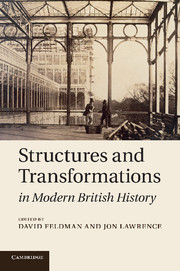Book contents
- Frontmatter
- Contents
- List of figures
- Notes on contributors
- Introduction: structures and transformations in British historiography
- 1 Coping with rapid population growth: how England fared in the century preceding the Great Exhibition of 1851
- 2 The ‘urban renaissance’ and the mob: rethinking civic improvement over the long eighteenth century
- 3 Forms of ‘government growth’, 1780–1830
- 4 Family formations: Anglo India and the familial proto-state
- 5 The commons, enclosure and radical histories
- 6 Engels and the city: the philosophy and practice of urban hypocrisy
- 7 The decline of institutional reform in nineteenth-century Britain
- 8 British women and cultures of internationalism, c.1815–1914
- 9 Psychoanalysis, history and national culture
- 10 Labour and the politics of class, 1900–1940
- 11 The dialectics of liberation: the old left, the new left and the counter-culture
- 12 Why the English like turbans: multicultural politics in British history
- Index
3 - Forms of ‘government growth’, 1780–1830
Published online by Cambridge University Press: 04 February 2011
- Frontmatter
- Contents
- List of figures
- Notes on contributors
- Introduction: structures and transformations in British historiography
- 1 Coping with rapid population growth: how England fared in the century preceding the Great Exhibition of 1851
- 2 The ‘urban renaissance’ and the mob: rethinking civic improvement over the long eighteenth century
- 3 Forms of ‘government growth’, 1780–1830
- 4 Family formations: Anglo India and the familial proto-state
- 5 The commons, enclosure and radical histories
- 6 Engels and the city: the philosophy and practice of urban hypocrisy
- 7 The decline of institutional reform in nineteenth-century Britain
- 8 British women and cultures of internationalism, c.1815–1914
- 9 Psychoanalysis, history and national culture
- 10 Labour and the politics of class, 1900–1940
- 11 The dialectics of liberation: the old left, the new left and the counter-culture
- 12 Why the English like turbans: multicultural politics in British history
- Index
Summary
During the 1960s and 1970s, when government accounted for some 15–20 per cent of UK employment and public expenditure stood at about 40 per cent of GDP, and when the welfare state seemed firmly set in place, the question when and how ‘government growth’ had originated seemed to an up-and-coming generation of historians both topical and compelling. By trying to answer this question, they hoped to create a historical context for scholarly and public understanding of the present.
It was generally accepted that the late nineteenth and early twentieth centuries had seen an important shift in gear. At that time, the civil service expanded considerably, and was reshaped so as roughly to resemble a Weberian rational bureaucracy. Elementary education was made first compulsory (1880) and then free (1891). The central as opposed to the local state acquired a role in financing welfare, with the establishment first of Old Age Pensions (1908) and then National Insurance (1911). All these developments attracted attention. It was, however, also common for writers of surveys and texts to look somewhat further back in search of the origins of ‘government growth’, at least to the 1830s – a decade which saw the first Privy Council grants in support of education, the establishment of a royal commission to look into the Poor Law (1833), the creation of the Poor Law Commissioners to administer the New Poor Law, and of Home Office appointed factory inspectors to monitor the implementation of the 1833 Factory Act.
Keywords
- Type
- Chapter
- Information
- Structures and Transformations in Modern British History , pp. 74 - 99Publisher: Cambridge University PressPrint publication year: 2011
- 2
- Cited by

